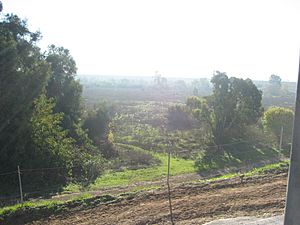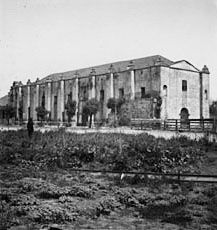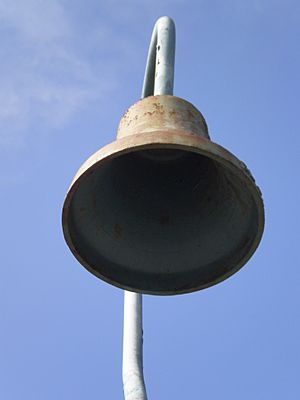Mission Vieja facts for kids
Quick facts for kids Mission Vieja |
|
|---|---|

Whittier Narrows, location of Mission Vieja from 1771 to 1776
|
|
| Location | Montebello, California |
| Built | 1771 |
| Designated | Jan. 11, 1935 |
| Reference no. | 161 |
| Lua error in Module:Location_map at line 420: attempt to index field 'wikibase' (a nil value). | |

The Mission Vieja, also called Misión Vieja or the Old Mission, was the very first Spanish mission built in the San Gabriel Valley. It was started in 1771 by the same priests who later built the famous Mission San Gabriel Arcángel. This important historical spot is now a California Historical Landmark (number 161). You can find its location today in Montebello, California, at the corner of North San Gabriel Blvd and North Lincoln Ave. There's a special plaque and an El Camino Real bell there. Mission Vieja was the first building ever constructed in the San Gabriel Valley and Los Angeles County.
Contents
Building the First Mission
Choosing the Location
Father Juan Crespí helped pick the spot for Mission Vieja. He chose it because there was plenty of water nearby. This area is now known as the Whittier Narrows. The location was first discovered during the Portolá expedition in the summer of 1769. Gaspar de Portolá, Miguel Costansó, and Father Juan Crespí wrote down what they found during their journey.
Starting Construction in 1771
In 1771, two priests, Father Pedro Cambon and Father Angel Somera, received permission from Governor Pedro Fages. They set out to build a mission in Alta California, which was part of the Spanish Empire at the time. This area is now called the Los Angeles Basin. The very first building was about 45 feet long and 18 feet wide. It was made from adobe (sun-dried mud bricks) and wood. The roof was built using tule reeds, which are tall grasses found near the water in the Whittier Narrows. A simple Palisade fence was built around the building for protection.
Life at the Mission Vieja
Founding and Early Success
Father Angel Somera and Father Pedro Cambon were both Franciscan missionaries. They officially founded Mission Vieja on September 8, 1771. This original mission was the start of what would become Mission San Gabriel Arcangel. Its location today is near the intersection of San Gabriel Boulevard and the Rio Hondo River.
Building this mission was a big step. It marked the beginning of Spanish settlement in the Los Angeles region. It was also the fourth of 21 missions that would eventually be built along California's famous El Camino Real. In its early years, Mission Vieja did very well. It was a successful farm and a place where cattle were raised.
Moving the Mission
After six years, in 1776, a very bad flood hit the area. The flood caused a lot of damage to the mission. Because of this, the priests decided to move the mission. They relocated it about five miles north. This new location is where the Mission San Gabriel Arcángel stands today, in the present-day City of San Gabriel.
Local History and Landmarks
Rancho Land System
In the early days of the mission, the land in the region was organized under a "Rancho" land grant system. This meant large areas of land were given to people by the Spanish or Mexican governments. The city of Montebello today includes land that was once part of three different ranchos: Rancho San Antonio, Rancho La Merced, and Rancho Paso de Bartolo.
Juan Matias Sanchez Adobe
The Juan Matias Sanchez Adobe is a historic building that was constructed in 1844. It is still standing today in the middle of what used to be Rancho la Merced in East Montebello. This adobe building has been restored recently. It is the oldest building still standing in Montebello.
Marker at the Site
A special marker stands at the site of Mission Vieja. It helps people remember this important historical place. The marker says:
- NO. 161 SITE OF MISSION VIEJA – 'Mission Vieja,' Old Mission, was the name given to the first buildings erected, and later abandoned, by the fathers for Mission San Gabriel Arcángel. The permanent buildings for the mission were located about five miles distant."


